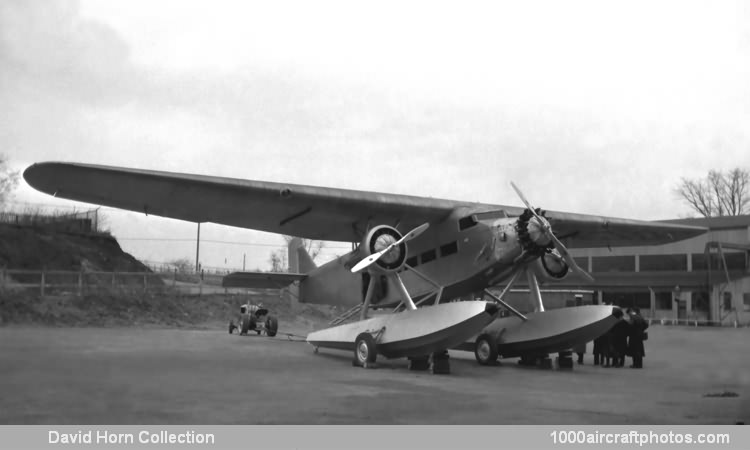04/30/2010. Remarks by Johan Visschedijk: "In the course of a career that began in the mid-1920s and which, many would claim, had hardly ended 50 years later, there can be few tasks that the Ford Tri-Motor has not attempted, including such unlikely activities as serving as a flying grocer's shop and performing snap-rolls at an air display. But it is as a go-anywhere, carry-anything passenger and utility transport that the Tri-Motor, affectively known as the "Tin Goose", is remembered with affection and respect by pilots and passengers alike.
The Tri-Motor's genesis, as a development of William B. Stout's 2-AT, was not a happy one. There is controversy still over who really did design it, and certainly no designer could have felt proud of the awkward, ugly 3-AT, the first attempt to turn the 2-AT into a three-engined aircraft. However, when a hangar fire conveniently destroyed this monstrosity, Harold Hicks and Thomas Towle led a drastic redesign which resulted in 1926 (first flight June 11) in the prototype 4-AT, powered by three 200 hp Wright J-4 Whirlwind seven-cylinder radial engines.
Seventy-eight production 4-ATs followed, of which the first 14 were 4-AT-As, similar to the prototype, with a two-seat open cockpit and cabin accommodation for eight passengers. The 4-AT-B, certificated in November 1928, seated twelve passengers, was powered by 220 hp Wright J5s, and had increased wing span. Of this version, 35 were built, followed by one 4-AT-C (with a 400 hp Wasp in the nose), three 4-AT-Ds (all with different power plants), 24 4-AT-Es (three 300 hp J6s), and a single 4-AT-F.
The improved 5-AT of 1928 featured a further increase in wing span, higher power and cabin seating for 13-15 passengers according to version. The 117 production total was made up of three 5-AT-As, 42 5-AT-Bs (certificated in June 1929), 48 5-AT-Cs and 24 5-AT-Ds. Re-engined or otherwise converted 4-AT/5-ATs appeared from 1929-31, leading to the designations 6-AT, 7-AT, 8-AT, 9-AT, 11-AT and 13-A. (The Ford 12-A was an unbuilt project; the 10-AT, unbuilt as such, was revamped as the 14-A and was an unrelated design.)
Production of the Tri-Motor ended in September 1932. Its career traverses virtually the whole pre-war period of airline development in the United States, and in all it served with more than 100 scheduled air transport operators in Australia, Canada, China, Mexico, the USA, and Central and South America, on floats or skis as well as the more usual wheeled landing gear. Others served with polar expeditions, as oil company executive transports, and as barnstormers or firefighters.
Countless individual modifications were made to cabin layouts, door shapes and sizes, internal equipment and other aspects of the aircraft. Although it was the only significant aircraft ever produced by the Ford company, the Tri-Motor is one of the immortals of aviation history.
The pictured aircraft was produced as a 5-AT-D and registered to National Air Transport as NC9657 on March 19, 1932, and subsequently owned/operated by Pacific Air Transport United Air Lines and G. Biederman, reportedly of Interamerican Aerotravel & Supplies Corporation in New York City. In the mean time it was fitted with Edo floats, and redesignated 5-AT-DS. On June 5, 1935, the aircraft was sold to SCADTA (Sociedad Colombo-Alemana de Transportes Aéreos, Colombian-German Air Transport Company) of Colombia, registered C-60 and named 'Barranquilla'. It was lost near Quibdo on May 15, 1938."
